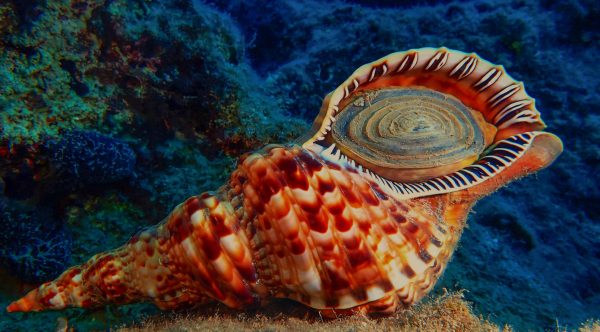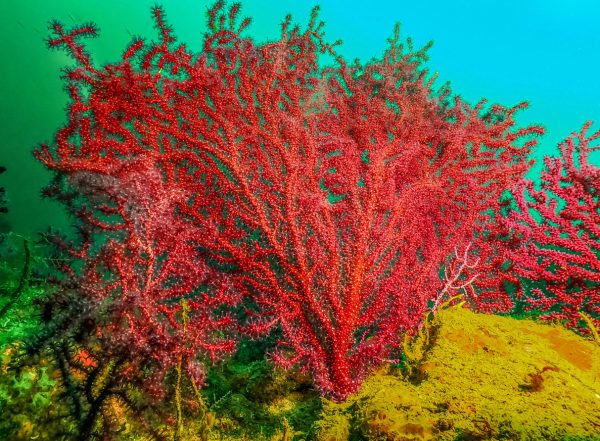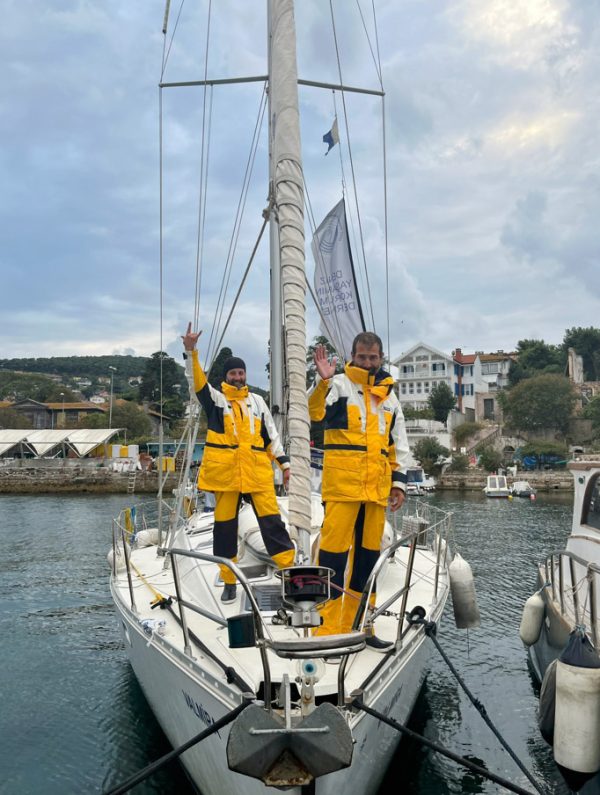Efforts to conserve sea biodiversity and raise awareness in this matter are gaining momentum in Türkiye, a country with a unique natural setting surrounded by seas on three sides. Increasing collaboration between the private sector and civil society organizations is observed in this regard. Continuing its support for environmental projects, Arkas Line has sponsored the book “Last Refuge Marmara,” written by Volkan Narci, President of the Marine Life Protection Association. The book unveils the hidden secrets of our seas’ depths through a diving expedition spanning from Türkiye’s Marmara shores to the Aegean and Mediterranean Seas, covering 100 different locations. Highlighting the vital importance of the Marmara Sea to the Black Sea, Aegean, and the Mediterranean, the book once again underscores the richness of our seas and the significance of our coastlines.
With this sponsorship, Arkas Line reaffirms its dedication and sensitivity to sea conservation. Volkan Narci, the book’s author and President of the Marine Life Protection Association, draws attention to the importance and biodiversity of our seas, sharing a wealth of scientific research, insights, historical findings, and experiences gained during the diving expedition.
How did the idea of writing a book about the Marmara Sea come about, what is its main purpose, and why this region?
I am one of the lucky children who grew up on the shores of the Marmara Sea, surrounded by stories that inspired fairy tales and had the opportunity to witness the enchanting miracles of the underwater world. For many years, I have been working to preserve this incredible biodiversity and have implemented numerous projects. The Marmara Sea has been the home to many civilizations in the past. It connects Asia and Europe, with the Bosphorus shining like a pearl necklace, providing life to the Black Sea in the north and the Mediterranean and Aegean Seas in the south. It possesses a magnificent cultural heritage that needs to be protected. Unfortunately, despite the pressure from humans, it continues to survive as a sea whose value is often unknown. If I were to say that our past, present, and most importantly, our future are connected to this sea, it would not be an exaggeration. It is essential for our existence; two out of every three breaths we take come from our seas. We must not forget that it is also a crucial trade route and a source of food for us. Perhaps because it has always been in front of our eyes, we have unintentionally neglected it for years. It is the source of the oxygen we breathe, the food we eat, and a life-supporting unit that regulates climate, nitrogen, and carbon. After my corporate life, I embarked on this journey to listen to the voice of the sea and protect its magnificent values. Over time, the national and international projects I have undertaken led me to learn and gather all this information, and as I learned, I was motivated to preserve and pass it on to future generations. The journey led me to gather and compile these known and witnessed values, with the support of experts, and to convey to you the importance of the Marmara Sea for our country, humanity, and the future. It all started with the struggle to create collective wisdom for its preservation and implementation of protection methods, not tomorrow, but today. But I can say that this whole journey and the process we have come to today is also a miraculous story.

What are the most striking findings from your 100 diving experiences?
I can talk about three clear topics. Firstly, the most important aspect that I can easily highlight is the incredible richness of life in the places I have reached or spent time diving, far away from human influence and pressure. Being in the city requires a constant battle, but in nature, it’s a completely different cycle. It was truly amazing to see the stars as if I could touch them, to dream, and to experience the tranquility of underwater and above-water life in a place without pressure, where it accepts you with trust.
Secondly, I have experienced the sadness of witnessing how much damage human presence and pressure can cause. Everywhere I went, it felt like a sign of destruction. You can clearly see the struggle between human pressure on nature and nature’s fight to preserve its own life resources.
Thirdly and finally, I can say that it was an incredible experience to discover dozens of places that I had never seen before, to be the first explorer, and to imagine like a modern traveler, experiencing the excitement that exploration brings. These experiences have given me unforgettable memories and inspiring emotions.
What kind of difference do you aim to make with your readers? What impact do you hope your book will have on its readers?
To show the unknown face of the Marmara… We all pass by its shores every day on our way home or to work, or we watch it in our most bored moments, sometimes in the most modern places, sometimes in the most humble places. We sit on a stone hill and watch it to calm down, turning inward. We eat the most delicious fish, but do we know the value of all this? Do we protect it? Does one hurt what they love? The Marmara is a younger sea. I aim to reveal the fact that we need to do our best to not lose all the richness it contains, and that we, the people living on the shores of this ancient sea, can only live by taking good care of it. We must learn to pause and manage our resources well to continue our lives. Nature will always find a way. But what about us? We must learn to live justly in this world. This is exactly what we expect from our readers to uphold these values.

What would you like to say about the environmental and economic importance of the Sea of Marmara? How would you evaluate the current situation and future of the region?
With so much research, experience, knowledge, and source scanning, I have witnessed that 428 common species living in the Mediterranean, Aegean, and Black Sea also live in the Sea of Marmara. If more research were done, we might reach completely different information and figures. A sea with so much value, both in terms of trade, industry, and being the focus of environmental impact, is also trying to resist the pressure of Turkey’s most populous cities and so many people, and we do not know how much longer it can do this. I think every citizen should choose candidates who will work for their own rights and nature, and for the future of all of us, from municipalities, relevant public institutions, lawmakers, or the leaders they will choose. Do we need a new park, landfill, building, or endless construction, or do we need the future heritage to be places where children can play sports, forests, green areas, conservation areas, the preservation of future natural resources, and absolutely no more waste being transferred to the sea without natural treatment? It really seems strange to me that so much work is being done to destroy the future of humanity by saying ‘I am serving humanity. We are all fighting for a living, so what is the result? Do we expect more polluted air, a dirtier environment, and a sea whose resources are on the verge of disappearing? I think we have not fully understood the concept of sustainability yet!
What is the general state of biodiversity in Turkey, and which species stand out in the Marmara Sea ecosystem?
Marmara is trying to resist all the pressure. I believe I can say the following about this amazing biodiversity. Firstly, Marmara is a sea that connects Europe and Asia, with ancient knowledge and a cultural heritage from the past. Secondly, it is an incredible biological corridor with the shared marine life and current systems of the Mediterranean, Black Sea, and Aegean. And thirdly, it is home to fan mussels, which are almost extinct in the Mediterranean, and hosts coral reefs that are unique to the Mediterranean. It is also home to important seagrass beds for the marine ecosystem and life. From seals to tuna, swordfish, sunfish, and sharks, doesn’t it make us more excited? It needs a bit of understanding and support for its conservation. Isn’t it worth it for all this biodiversity?

How was the writing process of your book? You also shot a documentary. What were your biggest challenges while researching or writing?
This question brought a nice smile to my face. Writing a book, creating a work, and collaborating with collective intelligence can truly be a test. It is a concept that we are not accustomed to after a certain age. This journey I embarked on was quite challenging, and as a result, I developed cracks in my feet. It turns out that there is a treatment process for foot cracks that does not involve casting, but rather requires you to rest and let your body heal on its own by simply stretching your feet. Of course, is it possible for someone like me to stay still for a long time? I went through this process in the best possible way. I read dozens of books, conducted research, read articles, and searched for sources to access memories. I don’t know how many books, articles, and sources I read. Afterwards, I compiled all this information, brought it together, designed the book, built enough trust to seek opinions from experts, made it appealing to readers, created accessible and navigable sources for researchers, and made it interesting for the new generation (QR codes), and reached out to all the supporters…
Each step could be written about separately, as I experienced numerous challenges. After overcoming all these difficulties, questions about the graphics, paper, compilation, and publishing house of this work arose. Finally, we reached the stage of finding sponsors and supporters. In short, the most challenging and difficult part is working with people, working with humans.
What steps do you think should be taken to increase awareness about sea and water resources? How do you think individuals and society can be more conscious about this?
I believe this is entirely a matter of culture, education, and priority policy, in other words, government policy. It should start with preschool and post-school education on topics such as the sea, water resources, the environment, animals, women, and children, to raise awareness among individuals. Then, it is necessary to convey what their legal and life rights are. As a result, it starts with questioning where and how the waste thrown from your home ends up. Then, the most important thing is for people to take care of the air they breathe, the food they eat, and learn to protect their own future. Perhaps we should create education models that support interaction with nature (such as nature camps, hikes, coastal clean-ups, volunteer programs) using technology and incorporating new education models that adapt to the changing times (such as VR, 3D, etc.) starting with preschool education. We will probably begin to see the results of this in 2 or 3 generations. It will become a way of life. Together, everything is possible.
Can you tell us about the Marine Life Conservation Association? What was its role in book projects? Are there any new projects for the association?
The Marine Life Conservation Association was established in 2015. Up to now, it has been managing projects in the Marmara Sea, focusing on the transplantation and restoration of endemic corals to form natural reefs, as well as the preservation of coral reefs, cleaning, and transformation of ghost nets from the seabed, biodiversity monitoring, conservation of species and habitats, preservation of underwater culture and heritage, and projects in the fields of art and sustainable design. As of 2022, it has been actively working with national and international partners for the benefit of all oceans and future marine life.
All these projects have played an important role in the creation of this book and serve as a valuable knowledge base. We have many future projects planned, and we can also develop projects tailored to institutions and objectives.
My mission in this process is to lead in areas such as sustainability consulting and project development, which allows my accumulated knowledge to be gathered in this book.
How can readers who want to access your book find it? In which publishing houses and on what date is your book available for sale?
The book was prepared with the support of Mazars Denge and Kariyo & Ababay Foundation. It was published by Yapım Ofset Publishing House under the sponsorship of Arkas Line within the scope of sustainability policies. There is truly a great effort behind it. Collecting so much information, memory, and statistical data, the difficulty of the journey is understood primarily by sailors, but it may also inspire a dream for the general reader. Every day, covering 30-50 miles, which is 40 nautical miles or 75 km, considering factors such as wind, waves, 2 dives per day, and the writing stage after processing the data, you might understand the difficulty of the work. Most importantly, bringing together so many institutions and individuals and uniting them around an idea has been an incredible experience. Our book, Last Refuge Marmara will be available in select bookstores, on the Internet, and through the pages of the Marine Life Conservation Association soon. Remember, Last Refuge Marmara!



